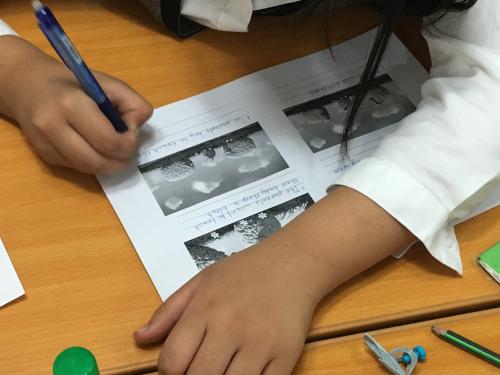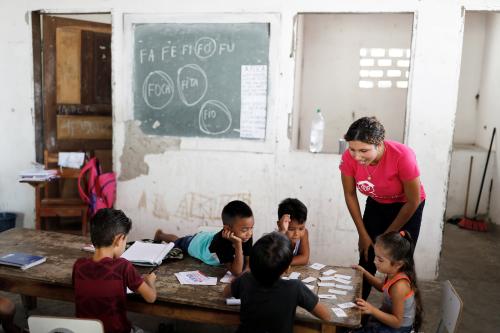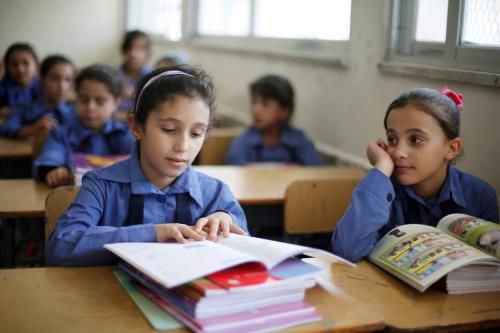This is the fourth post in a series about using data from 21st century skills assessments.
Across all education systems, the main purposes of assessment are the same, though the types of assessment may vary. As discussed in a recent Brookings report, local contexts, such as resources, national priorities, infrastructure, and human resources, affect a country’s approach to using assessment data. In Nepal, one focus of national policy has been on formative assessment—including class, project, and community work and application tasks—as part of the country’s continuous assessment system in the basic levels (up to grade seven). Starting from grade eight, more standardized and centralized assessments are implemented, such as system-wide examinations in the lower and upper secondary levels.
Challenges and opportunities in learning assessment
Nepal recognizes that to improve children’s learning, the most effective assessment is classroom-based, formative, and continuous. Nepal’s continuous student assessment systems are intended to identify students’ learning achievement, help weaker students, and conduct remedial teaching that encourages learning. However, the policy is difficult to implement for reasons including lack of teachers, large classrooms, and learning disparities.
As is common in developing countries, factors such as large class sizes, educational resources, and work overload impact the proper implementation of continuous assessments. These challenges are compounded by limitations in personnel capacity, such as lack of understanding of cognitive processes behind 21st century skills and limited professional development in assessment practices. At the leadership level, there are also challenges in the planning of formative assessment, which impacts effective implementation in the classroom.
However, some public schools are initiating reforms to enhance assessment practices and improve the use of data for teaching and learning. For example, assessment results may be displayed in the school office and staff rooms, and some schools organize parent meetings after disseminating assessment results to discuss children’s learning and developmental progress. A newly formed local-level government (village and municipal) has also started to use assessment data to concentrate more on students’ learning, which is an improvement on the traditional use of assessment for accountability only. This local-level reform is coupled with a more coherent approach to assessment. Basic-level examinations are conducted at local or municipal levels. To increase the educational quality and assessment practices, local governments are moving to create local examination committees, use standardized tool development, and increase the use of technology in the classroom.
Since 2011, Nepal has implemented a national, sample-based assessment through the National Assessment of Student Achievement program. This assessment program provides a broad summary of learning status at the country level and reports results in various formats for public and technical communications. While useful for informing system-level interventions and policy reforms, to date this data has not been accessible for use by teachers in the classroom.
More work to do
There is still much work to do in Nepal. The formal learning system is largely dominated by prescribed curriculums and textbooks, and the majority of teachers depend on textbooks for teaching and assessment. The educational assessment systems still largely rely on traditional paper-and-pencil tests. In addition, school-based assessments and public examinations mainly focus on content knowledge rather than on skills and processes. Assessment of 21st century skills is still uncommon, similar to other developing countries in the region, as reflected in a 2016 study by UNESCO-NEQMAP. Assessment practices are strongly influenced by the prescribed national assessment frameworks, which reduces the flexibility of schools and teachers in developing their own classroom assessments and practices. Many teachers still have the mindset that summative assessments are the only means to qualify student achievement, and most parents are focused on the grades and not comprehensive feedback on their children’s learning.
Assessment should be used to improve learning, as well as to improve teaching practices in classrooms. Fortunately, there have been signs of change: Many government schools are starting to use classroom-based assessment as part of a quick feedback system, and teachers are using past assessment questions to understand skills that can be generalized to other tasks.
Nepal’s use of assessment data to improve learning and teaching practices in the classroom highlights the challenges in getting teachers to understand the skills being measured, effectively use assessment data, and implement policy interventions. However, small changes currently underway have the potential to change assessment practices and data use in the future, and are slowly being encouraged in a bottom-up approach—starting from the classroom and school.







Commentary
How educators use assessment data to improve student learning in Nepal: Challenges and solutions
January 25, 2019